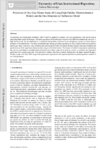1 - 25 of 11
| Creator | Title | Description | Subject | Date | ||
|---|---|---|---|---|---|---|
| 1 |
 |
Eddings, Eric G.; Sarofim, Adel F. | Olefin chemistry in a premixed n-heptane flame | Three different n-heptane mechanisms were used to simulate a fuel-rich normal heptane premixed flame in order to identify major reaction pathways for olefin formation and consumption and areas of uncertainties of these reactions. Olefins are formed mainly via ?-scission and hydrogen abstraction, and... | Heptane mechanism; N-heptane; Olefin formation; Olefin consumption; Alkyl radicals | 2007 |
| 2 |
 |
Eddings, Eric G.; Sarofim, Adel F. | Journey from n-heptane to liquid transportation fuels. 1. The role of the allylic radicals and its related species in aromatic precursor chemistry | The Utah normal heptane mechanism compiled from submechanisms in the literature was extended into a detailed normal decane combustion mechanism, which is a subset of the Utah surrogate mechanisms. Few species have greater impact on the concentrations of other species than the allyl radical CH2CHCH2.... | Utah Surrogate Mechanisms; Heptane mechanism; Decane combustion mechanism; Allyl radical; Aromatic precursors | 2008 |
| 3 |
 |
Eddings, Eric G.; Sarofim, Adel F. | Pollutant emissions from gasoline combustion. 1. Dependence on fuel structural functionalities | To study the formation of air pollutants and soot precursors (e.g., acetylene, 1,3-butadiene, benzene, and higher aromatics) from aliphatic and aromatic fractions of gasoline fuels, the Utah Surrogate Mechanisms is extended to include submechanisms of gasoline surrogate compounds using a set of mech... | Pollutant emissions; Soot precursors; Gasoline surrogate compounds; Utah Surrogate Mechanisms | 2008 |
| 4 |
 |
Sarofim, Adel F.; Truong, Thanh | Kinetics of hydrogen abstraction reactions from polycyclic aromatic hydrocarbons by H atoms | An application of the Reaction Class Transition State Theory/Linear Energy Relationship (RC-TST/LER) is presented for the evaluation of the thermal rate constants of hydrogen abstraction reactions by H atoms from Polycyclic Aromatic Hydrocarbons (PAH). Two classes of reactions have been considered, ... | Reaction Class Transition State Theory; Linear Energy Relationship; Hydrogen abstraction reactions | 2004 |
| 5 |
 |
Eddings, Eric G.; Sarofim, Adel F. | Mechanism reduction and generation using analysis of major fuel consumption pathways for n-heptane in premixed and diffusion flames | Reaction pathway analyses were conducted for three mechanisms (designated as the Pitsch, Utah, and Lawrence Livermore National Lab) for a normal heptane premixed flame (? = 1.9) and a normal heptane opposed diffusion flame, in order to identify the relative importance of the major fuel consumption p... | Pitsch mechanism; Utah mechanism; Lawrence Livermore National Lab mechanism; Mechanism reduction; Heptane premixed flame | 2007 |
| 6 |
 |
Sarofim, Adel F.; Pugmire, Ronald J. | 13C NMR analysis of soot produced from model compounds and a coal | Soot samples, including the associated organics, produced from an Illinois No. 6 coal (five samples) and two model compounds, biphenyl (three samples) and pyrene (two samples), have been studied by 13C NMR methods. The coal soot data served as a guide to selection of the temperature range that would... | 13C NMR; Biphenyl; Aromatic cluster size | 2001 |
| 7 |
 |
Whitty, Kevin J. | A pulse-width modulation controlled wire-mesh heater apparatus for investigation of solid fuel pyrolysis | A novel wire mesh heater apparatus has been developed to study the devolatilization of solid fuels under pressurized conditions at well-controlled heating rates on the order of 1000 K/s. The apparatus combines direct current and pulse-width modulation with a fast-acting and high current-capacity re... | 2012-01-01 | |
| 8 |
 |
Pershing, David W. | Biomass combustion: relationship between pollutant formation and fuel composition | A 65-kW refractory-walled reactor was used to study biomass combustion under conditions typical of the suspension-burning phase in a spreader-stoker-fired boiler. Isothermal combustion data and nitric oxide (NO) emission rates were obtained as a function of temperature, local oxygen concentration, ... | Combustion; Emissions; Energy; Environmental control; Fuels; Pyrolysis; Biomass fuel; Particulates | 1989 |
| 9 |
 |
Eddings, Eric | Modified CPD Model for Coal Devolatilization at UCTT Conditions | To study coal pyrolysis behavior at underground coal thermal treatment (UCTT) conditions, a modified CPD (M-CPD) model was developed and evaluated using two scales of experiments as well as two different coals, Utah Sufco and Illinois #6. Compared with the original CPD model, three major aspects wer... | Coal; pyrolysis; modeling; underground heating | 2019 |
| 10 |
 |
Pershing, David W. | Mechanisms of NOx formation and control: alternative and petroleum-derived liquid fuels | Petroleum-, coal- and shale-derived liquid fuels were burned in a downfired tunnel furnace to assess the impact of fuel properties on the formation and control of NOx emissions. A nitrogen-free oxidant mixture (Ar, C02 , 02) was used to isolate fuel NOx formation. Under excess air conditions fuel N... | Exhaust emissions; Alternative fuels; Petroleum-derived liquid fuels | 1981 |
| 11 |
 |
Sutherland, James Clayton | Prediction of oxy-coal flame stand-off using high-fidelity thermochemical models and the one-dimensional turbulence model | An Eulerian one-dimensional turbulence (ODT) model is applied to simulate oxy-coal combustion, with specific aim at predicting flame stand-o distances. Detailed gas-phase chemical kinetics based on the GRI3.0 mechanism are utilized. A high-fidelity model for devolatilization is considered that predi... | 2014-01-01 |
1 - 25 of 11
